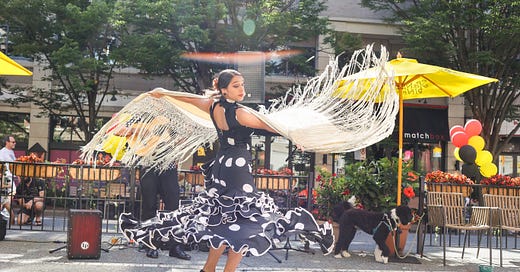Hola amigos, I hope you had a nice weekend. Eat anything good to welcome in December?? Did any of you make a test batch of the turrón de chocolate? How good is it!
Today I want to tell you about something not directly related to food…but I promise you’ll love it.
I’ve told you before about Andalucía, in the south of Spain—it’s one of my favorite regions for many reasons. It’s where my wife Tichi is from, so we have a lot of family there and we visit in the summertime and throughout the year. It’s where gazpacho originated, a soup that I love so much (because Tichi makes the best one). And also it’s the birthplace of sherry, which is a great pairing for so many Spanish dishes.
But today we are talking about something else that comes from Andalucía…Flamenco! Did you know that I love to dance? I actually met Tichi on the dance floor back in the day at Cafe Atlántico, one of my first restaurants in Washington, which in its earliest days had an amazing dance floor and record collection (maybe someday I can tell you all about the history of Atlántico!)
But of course, I wasn’t dancing Flamenco…I leave that to the professionals. Flamenco, which UNESCO recognized in 2010 as part of the World’s Intangible Cultural Heritage, came to Spain from northwest India back in the 9th century with the Roma people, known as Gitanos in Andalucía (there is cultural and historical issues around what the Roma people are called everywhere they live, but in Spain, gitano and gitana are most common). The Gitanos brought with them deep traditions of song and dance that evolved to become what we now call Flamenco—a word that actually was once used to describe the Gitanos themselves.
While most of us probably associate Flamenco with the dancers in their incredible brightly colored, floor-length dresses with ruffles (and the men in their much more simple outfits), it is actually a number of forms of artistic expression. It includes poetry, singing (cante), guitar playing (toque), dance (baile), hand-clapping (palmas), and finger snapping (pitos).
Probably the most well-known form of flamenco (and one of my favorites) are the dances along with the guitar playing, together telling stories of a love, loss, grief, passion…it is a very soulful and moving form of dance that tells a story with every movement, so full of powerful emotion.
And the way Flamenco singing and dancing is evolving is amazing…do you guys listen to the music of Rosalía, who was trained as a Flamenco singer and has become an international star? Or C. Tangana, who did an amazing Tiny Desk Concert a few years ago, showing us the past, present, and future of the art.
If you haven’t been able to see Flamenco live in person, you really have to…the music, the rhythms, the claps, the dancers and their movement—it really makes you hold your breath for minutes at a time, as you feel the stories through your whole body.
And friends…if you live in either Chicago or are visiting Disney, you are in luck! At Jaleo in Chicago we have Flamenco guitar—the toque of Flamenco—every Thursday, and at Jaleo Disney we are hosting performances on Fridays!
You can also watch my daughters and I dance Flamenco in the episode about Andalucía on my show José Andrés and Family in Spain which you can stream on Max.
My friends…have you ever seen Flamenco live? Did it move you as much as it moved me?





I fell in love with Cante Jondo in Sevilla seeing Camaron and Tomatito ... I created a Flamenco festival in London with Fernanda and Bernarda des Utrera , Jose de la Tomasa , Manolito Chica , La Negra , Angelita Vargas , Lole and Manuel audiences in London were KNOCKED OUT each night !!!... spending months in Spain amongst some of the greatest artist was truly a highlight of my cultural life . To hear you speak of your passion and joy went directly to my soul ... I hope to get back to the spring / summer festivals and see this generations artist ... and maybe run into you and your family !!!! ❤️
I grew up in NY listening to Lola Flores sing and other flamenco artists blare from the stereo. My abuela, from La Linea, invited the entire flamenco troupe from the Spanish Pavilion at the 1962 Worlds Fair to her home AND THEY CAME. I was 5 but still remember the guitars, the singing and the flamenco dancing on the kitchen table. And, I discovered José Andres at Cafe Atlantico and I have been a fan ever since. Gracias for sharing our cultura.